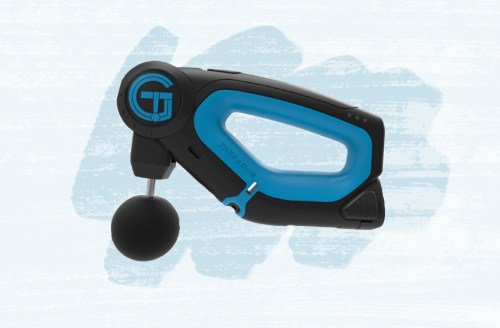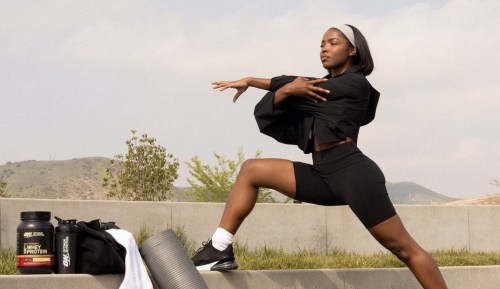Our editors independently select these products. Making a purchase through our links may earn Well+Good a commission
Theragun review: How well the recovery tool actually works
As marathon season tops out, this is what to know after a review of the buzzy device called the Theragun, plus pro advice on why it's great.

It’s marathon season and my tiny apartment has little storage. Those two things shouldn’t have a ton to do with one another, but in a twist of fate, they’ve led to the best party trick (and best recovery season) I’ve ever known. Nowadays, to the left of my couch sits a contraption I took some time to review that looks equal parts futuristic and functional: The Theragun. Anytime someone new comes over, they ask with stars in their eyes: “What is that?” “It replaced foam rolling for me,” I tell them—and in an instant everyone wants to try. I switch it on and just like that, people are impressed.
What are the benefits of using a recovery tool?
Unlike some wellness experiences, you’ll never be confused on whether or not the Theragun is working. This is both because it’s quite loud (it sounds a bit like a drill being used) and because it brings instant relief to sore, tight muscles with long-lasting benefits. Where I find it more difficult to isolate trigger points with a foam roller, the Theragun makes it way easy to get into every nook and cranny. Where I hate hovering above a cylinder and moving back-and-forth, I can just chill on my couch with the TG as I’ve affectionately named it.
“Vibrational therapy can help with pain, muscle soreness or tightness, and recovery. It can be an inexpensive alternative to massage to help maintain performance by working out trigger points and knots and preventing the build up of lactic acid in the muscles,” says Michigan-based physical therapist Lauren Lobert, DPT, OMPT, CSCS and owner of APEX Physical Therapy. “Plus, it feels good.”
How does Theragun work and what areas of my body should I target?
Theragun and other percussion devices like the Hypervolt ($349) are used over any area that’s sore but, in my experience, they deliver a slighter sensation because of the rapid movement (the Theragun fires at 40 percussions per second). “You can use it over any muscular area. You want to avoid bone, and it won’t feel great if you put it right on your bone anyways,” says Lobert. And there’s plenty of science to help back this up: “A study revealed that vibration devices helped prevent delayed onset muscle soreness and pain, and also decreased levels of lactic acid for 48 hours after working out, while another demonstrated that vibration therapy used before eccentric exercise reduced delayed onset muscle soreness,” she says.
How much does a theragun cost and is it worth it?
Inexpensive is relative, however: The device, which costs a pretty penny at $599, isn’t exactly cheap. But as the quality of our recovery becomes as important as our workouts, the Theragun becomes essential (hey, $100 massages here, $50 stretches there can add up quickly). So while the cost is a lot upfront, it can save those one-off treatments and potentially even fend off injury-related costs that result from too-tight muscles as mileage climbs. “The reason I created this 10 years ago was to deal with constant pain that I was experiencing,” says Theragun founder Jason S. Wersland, D.C. “If you lay on a foam roller, that’s a constant impact. Your brain gets that it’s painful, that hurts, if you can do the same type of treatment minus the pain, you’re building collagen, you’re creating new tissue so it’s helping your body recover.” And anything that takes the edge off 26.2 from the comfort of my own couch is A-OK by me.
Also, here’s how to tell if you’re stretching the right way and these are the two components any successful stretching routine has.
Sign Up for Our Daily Newsletter
Get all the latest in wellness, trends, food, fitness, beauty, and more delivered right to your inbox.
Got it, you've been added to our email list.










